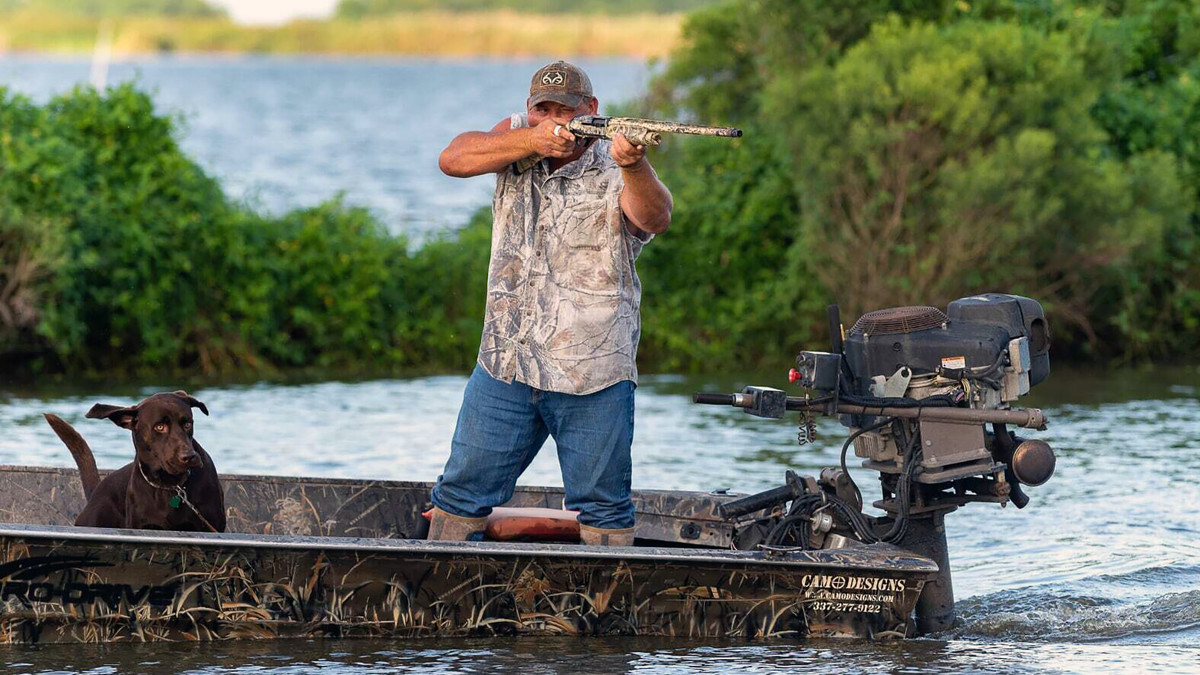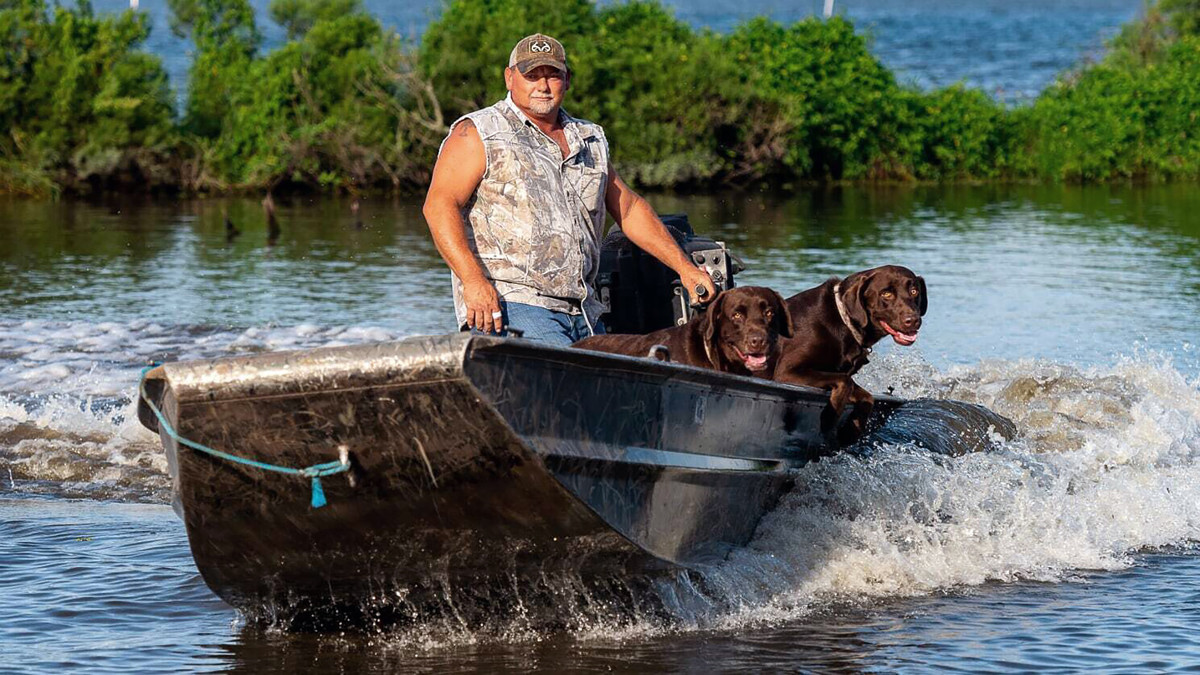
In this Aug. 8, 2019 photo, Justin Choate hunts nutria from his boat in the wetlands near the Louisiana coast. Choate, 43, has been around Louisiana's waters all of his life. He started working those marshes, streams and bayous with his father at the age of 9. When he's not serving as an alligator guide, he's out hunting nutria, the invasive, orange-toothed swamp rodent that's devouring Louisiana's coast. (Scott Clause/The Daily Advertiser via AP)
PECAN ISLAND, La. (AP) - Drive until you see the Gulf of Mexico, and before you hit the water take the last left on a dirt road. That's where Justin Choate lives.
Choate, 43, has been around Louisiana's waters all of his life. He started working those marshes, streams and bayous with his father at the age of 9.
When he's not serving as an alligator guide, he's out hunting nutria, the invasive, orange-toothed swamp rodent that's devouring Louisiana's coast.
The state's marshes are so overrun with nutria that it doesn't take much for Choate to bag enough to call it a day. A couple of times a week during hunting season, from November to March, he's out from daylight to 10 a.m. and then 3 p.m. to dark. It's easier working the swamps during the coolest hours.
Choate kills at least 120 nutria a week, as many as 6,000 a season - his best day: 238 nutria in less than 11 hours.
If he doesn't kill them with his rifle, one of his three chocolate labs - Jake, Buck or Duke - will spot one, kill it and bring it back to the boat. Some days, the hunting dogs are quicker than Choate.
For the longest time, he and other hunters had only a few uses for the dead nutria - skin them for the fur, turn their tail in for $6 each from the state and use the rest as alligator bait.
But now there's another reason to make nutria a target. The destructive mammal that has hastened the loss of hundreds of miles of Louisiana coast now can serve as the main ingredient in dog treats.

In this Aug. 8, 2019 photo, Justin Choate shows off a taxidermied nutria and opossum at a home near the wetlands on the Louisiana coast Choate, 43, has been around Louisiana's waters all of his life. He started working those marshes, streams and bayous with his father at the age of 9. When he's not serving as an alligator guide, he's out hunting nutria, the invasive, orange-toothed swamp rodent that's devouring Louisiana's coast. (Scott Clause/The Daily Advertiser via AP)
Hansel Harlan wants to convert Louisiana's nutria problem into a nationally distributed dog biscuit. Marsh Dog, the Baton Rouge pet food company he co-founded, uses wild nutria as the main ingredient in its new generation of dog treats.
In 2012, the company received a grant from the Barataria-Terrebonne National Estuary Program to begin production of the dog treats, which mostly have been sold in Louisiana stores. But now Marsh Dog has partnered with a larger manufacturer, tweaked its production process and set its sights on building the brand.
The goal is to help to eliminate as many nutria as possible to reduce the destruction of Louisiana wetlands. There are no other commercially produced dog treats that use protein from non-domesticated mammals like nutria taken from the wild, Harlan said.
The company gets its nutria from the 4.1 million-acre estuary, located between the Mississippi and Atchafalaya rivers in south Louisiana.
Marsh Dog gets the majority of its nutria meat from the 400 licensed trappers in the state, most of whom participate in the nutria control program with Louisiana Department of Wildlife and Fisheries.
Although the number of nutria killed by trappers each year has decreased, Harlan and his business partners hope to help increase that number.
After the state control program began, 2010's hunting season ended with a record 445,936 nutria killed. That number dropped to a low of just over 170,000 killed in the 2018 season and about 223,000 killed when the last season ended in March.
With nutria averaging about six to 10 pounds each and each providing nearly half that in usable meat, Marsh Dog uses hundreds of thousands of pounds each year for their biscuits. The company could get rid of more than 55,000 nutria each year.
The company "found a sustainable solution for the planet," said Dr. Marvin Moncada, research and development food scientist at Louisiana State University's AgCenter Food Incubator. He worked with Marsh Dog to reformulate their products and extend shelf life. "Why kill it if you won't use it?"
Harlan came across the unconventional meat thanks to his dog, Chien du Marais, French for Marsh Dog, who has chronic allergies. He developed the recipe so it wouldn't trigger an allergic reaction.
Jennifer Hogue-Manuel, a biologist with the state's wildlife and fisheries department, said making dog treats from nutria is a helpful, unique idea, though it might be a hard sell with the negative rat connotation. Nutria are most closely related to porcupines or South American capybaras, which is a source of protein for the subtropical countries such as Argentina, Chile and Uruguay.
"(Marsh Dog) has done testing," Hogue-Manuel said. "They're high in protein, low cholesterol. They're a good option."
Nutria were brought to Louisiana in the 1930s for fur farming and somehow escaped to the coastal wetlands of south Louisiana, where they rapidly grew in population. How they escaped is unclear, explanations steeped in folklore - perhaps Edward Avery McIlhenny, son of Tabasco mogul Edmund McIlhenny, released all of his nutria into the marshes in 1945, or maybe a hurricane destroyed most nutria enclosures in the 1940s.
By 1960, state wildlife officials estimated there were 20 million nutria roaming the Louisiana wetlands.
Despite a slowed rate of coastal wetland loss in Louisiana since 2010, the U.S. has still lost about half of its wetlands over the past 200 years. Since the 1930s, one-quarter of Louisiana's coast has disappeared.
Usually nutria damage plants' root systems, making the re-vegetative process slow. The damaged plants are soon no longer able to protect the wetlands, making it vulnerable to tides that can erode what little remains.
Wetlands and swamps help to protect against hurricanes. They absorb much of the wind and water moved into coastal communities and filter carbon to counter climate change. It also provides food and habitat for wildlife like endangered whooping cranes, and support the more than $1 billion a year seafood industry.
After three years of low nutria catches, LDWF increased the nutria bounty from $5 to $6 for every tail in 2019. In order to reduce the nutria population, the agency sets a yearly goal of 400,000 trapped nutria. Since the program started in 2002, this goal has only been achieved in 2010's record season.
Dr. Cherie M. Pucheu-Haston with the LSU Veterinary Dermatology said nutria meat is a unique source of novelty protein - a new protein most pets haven't come in contact with. She joked that she has always wanted to start a nutria farm to supply a novel protein to some of her food allergic patients.
Nutria meat has similar nutritional value to other common meat sources; it even has slightly lower cholesterol than beef, she said. She cited two science journals, one that took into consideration the levels of fat and cholesterol, while the other looked into acids and minerals.
The meat is a healthy alternative that complies with current healthy and dietary recommendations for low-fat, low-cholesterol diets, according to the Journal of Food Composition and Analysis.
Taking into account the protein content and amino acids composition, fatty acids and minerals of farmed nutria, the nutritional value of nutria meat is even adequate for human nutrition, especially when it comes to providing iron for children and women, according to an analysis by the Meat Science journal.
The state even made an effort in 1993 to promote the human consumption of nutria, resulting in Nutriafest and celebrity chef Paul Prudhomme offering savory recipes for nutria sausage, etouffee and gumbo. But the festival never caught on, thanks to the negative perception of nutria.
"Now, I am not a nutritionist, so take this with a grain of salt," Dr. Pucheu-Haston said, "but it doesn't look like it would be bad for dogs to eat nutria meat, nutrition-wise, at least at the same proportion that it would be OK to eat any other meat."
Choate has been trying to put a dent in the nutria population for decades. Living on the gulf keeps him aware of the effects nutria has on erosion. He also knows the chances of a shortage are slim due to breeding habits. They re-populate rapidly with a litter every eight weeks and females being able to have babies at just 12 weeks old.
Seeing full nutria traps and getting paid for the pelts used to be Choate's favorite part of hunting, until the fur market dissipated. The tail bounty has been helpful, but now he can get paid for the meat.
Marsh Dog wants to relieve tax payers of the $2 million used to pay tail bounty help eradicate nutria from wetlands with a commerce solution. The company uses hundreds of thousands of pounds of nutria meat, and the number is growing each year Harlan said.
"Our ultimate goal is to go out of business," co-founder Veni Harlan said.

In this Aug. 8, 2019 photo, Justin Choate kills at least 120 nutria a week near his home on the Louisiana gulf coast. Between him and his three chocolate labs, they can hunt as many as 6,000 nutria a season. Choate, 43, has been around Louisiana's waters all of his life. He started working those marshes, streams and bayous with his father at the age of 9. When he's not serving as an alligator guide, he's out hunting nutria, the invasive, orange-toothed swamp rodent that's devouring Louisiana's coast. (Scott Clause/The Daily Advertiser via AP)